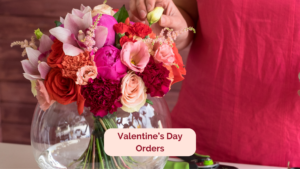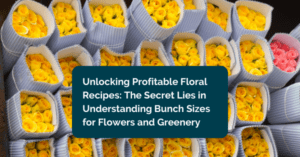Floristry can be a rewarding experience for those who are passionate about flowers and floral arrangements. It gives you an opportunity to creatively express yourself. But eventually, you second-guess your choice by asking yourself, ‘Are florists profitable?’. Well, the answer varies. Turning a small-scale floristry into a profitable business requires patience and effective strategy. Developing unique and stunning flower recipes is the key to achieving success in the ever-changing floral industry. Whether you’re an event florist, floral designer, or a floral shop owner, understanding floral pricing can help you maximize profits while keeping the quality of your services intact. In this comprehensive guide, we’ll walk you through the best practices of a successful floral business.
What is a floral recipe?
Floral recipes are essential to make your business sustainable and to achieve maximum profit. Think of it as a blueprint for a floral arrangement. A profitable floral recipe should consist of a list of floral materials, greenery, hard goods such as vases and containers, and a step-by-step instruction for bringing it all together. Moreover, an exceptional floral recipe system always comes with photos or sketches of the finished design for reference and clarification.
Understanding floral pricing: why markup matters
Pricing is a non-negotiable factor in determining the overall success of your floral business. In the floral industry, markup refers to the profit margin a florist adds to cover the overall cost of a floral project, excluding the flowers. To calculate the pricing formula, you add up the total cost of flowers and multiply that by the profit percentage (markup) to set the selling price of your floral arrangement. The standard markup is 3.5, which is widely used across the floral industry. This means the selling price is 3.5 times the actual cost of the flowers used. Having a definite and effective markup paves the way for a sustainable floral business.
Now that you’ve understood the significance of markup let us move ahead and learn the common mistakes to watch out for when navigating the pricing process.
Red flags you need to avoid when setting pricing
Downplaying greenery:
Setting a low markup, like 2.5 or 3 for greenery, means a loss of profit. Many florists tend to undervalue the greenery, thinking it’s not as profitable as the blooming factor, which is just plain wrong. Let’s be real: both greenery and flowers are fragile and require the same level of care. Imagine you order a flower bouquet for your wedding party, and it comes with only flowers without a trace of green. Would that look flattering to you? Probably not. Greens are an essential element in floral design that enhances the overall look of the project. That’s why it’s important to set the same markup for greenery.
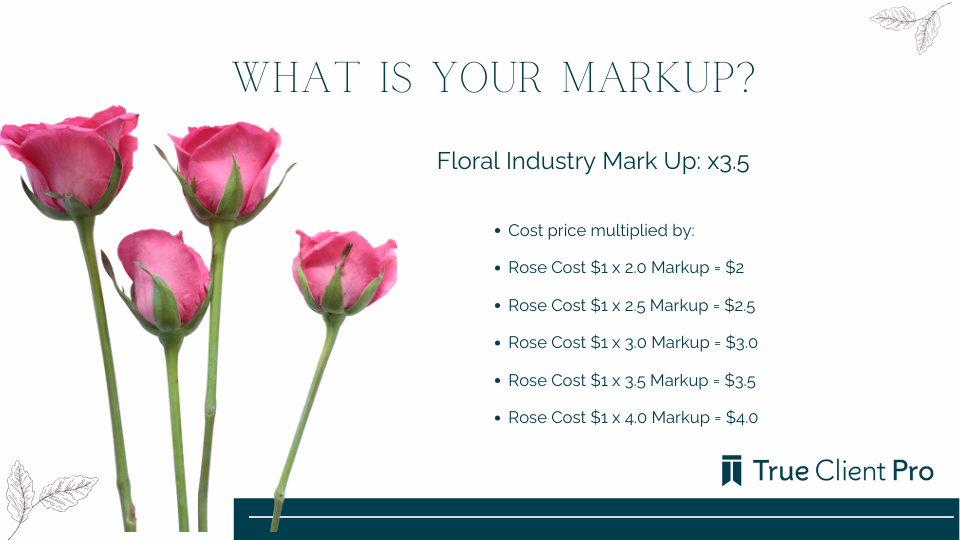
Overlooking hard goods:
An excellent floral recipe doesn’t just contain flowers; it comes with decorating factors to make the whole design aesthetically pleasing. These non-floral elements include pins, ribbons, vases, floral foam, wire, containers, and cardboard boxes for packing and delivery. You have two possible conditions for setting up the markup for these items, i.e., bulk purchasing and per-event purchasing. Now, let’s break it down. Bulk purchasing of hard goods demands storage space and capital investment. Florists carefully manage their hard goods inventory for future projects, which is time-consuming and accounts for extra costs (due to storage space). In contrast, event purchasing calls for buying items on an as-needed basis. The industry markup for event purchasing is typically 2.5. However, there’s no full guarantee that all your items will get used up. That’s why you need to carefully consider setting a markup that will cover your storage expenses. Determining the right markup for hard goods can make a huge difference in your profit margin. By avoiding these two basic mistakes, you’re substantially increasing your profit margin. While we’re on the topic of increasing profit, let’s take a look at order, which is another crucial profit-determining factor.
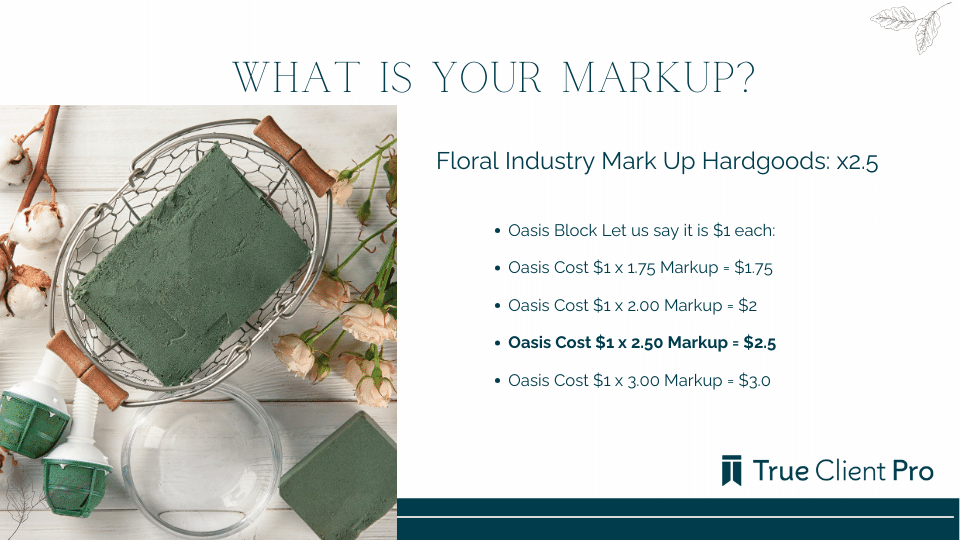
Finding the right balance: dodge over-ordering and under-ordering
Among many challenges a florist can face, finding the right order balance may be the most common.
Ordering flowers on a large scale makes way for unnecessary wastage since they have a limited shelf life. It usually piles up and starts to decompose if you delay disposing of it. It also contributes to increased financial loss.
While under-ordering seems like a safe choice, it’s not proven to be effective in all cases. Imagine you get a lucrative offer, and at the last minute, it hits you that you’re actually short on flowers. Or hard goods? This leads to spiked anxiety, operational disruption, and last-minute preparation. Additionally, when you rush to source those extra flowers, there’s a risk of increased costs since you’re not buying them in bulk.
These scenarios call for effective inventory management. How can you minimize wastage, reduce extra costs, and maximize your profit? Well, no need to stress. Let’s make this easier for you.
In Floral Software such as True Client Pro, you can add your preference for each item ahead of time for markup and price to reduce the guessing game while creating your floral recipes. Part of the profit is calculated risk; you can learn more about Maximizing your profit for a project.
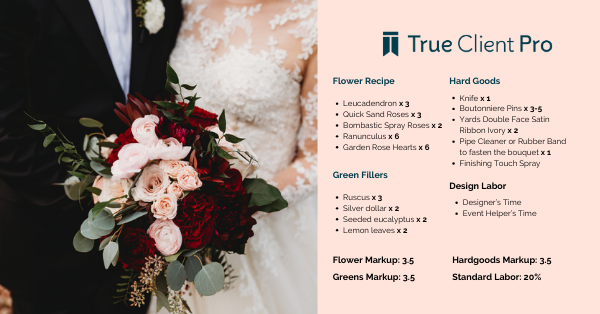
How do you order effectively?
Analyse market trends:
Seasonal fluctuations are the key factor that determines your order. Look out for holidays (Valentine’s Day, Mother’s Day, Christmas), festivals, and wedding seasons that call for increased demand. You can overstock around this time without stress. While on slow periods, reduce your orders to minimize waste.
Practice FIFO (First in, First out):
Keep track of your past sales and use up the flowers on an arrival basis. This makes sure you’re not overlooking any flowers.
Store them properly:
Invest in a good storage room with appropriate temperature (usually 34°F – 38°F) to slow down wilting and increase lifespan. It ensures your flowers are fresh for longer periods and decreases the chance of over-ordering.
Build good supplier relationships:
Having a good relationship with suppliers gives you more freedom and flexibility in your orders. Familiar suppliers usually go easy on you during your last-minute panic and set the usual prices for you.
Now that we’ve covered the basics of effective ordering let’s move on to labor allocation, which is another major takeaway for a profitable floral business.
Effective labor distribution: Work Smarter, Not Harder
Cutting down on labor costs while still maintaining the integrity of your floral designs can be done through careful planning. However, it’s important to redistribute tasks fairly without bias.
Non-design task: Having trained support staff for cleaning up and arranging floral materials pre- and post-design allows lead designers to focus on making gorgeous floral recipes for maximum profitability.
Design tasks: Assign your designers to the main task, that is, floral design, to save time and cost.
Benefits of effective labor distribution:
A floral business can flourish with smart labor allocation. The major benefits include increased productivity, improved efficiency and time-to-market, cost reduction, and capacity for more projects.
Final words
By combining creativity and profitability, you can aim for a successful floral business without compromising quality. Understanding floral pricing, balancing ordering, and allocating tasks effectively, you can thrive in your floral business. These are the factors that make a florist profitable. Scaling up your business from scratch requires patience and practice. By following the best floral practices, you’re not just making profits but also paving the way for many aspiring florists who are looking out for meaningful opportunities.
Ready to soar high and take your floral business to the next level? True Client Pro, a floral management software, can help you streamline your business and guarantee the best benefits for you. Contact them further to learn about the services they offer.


